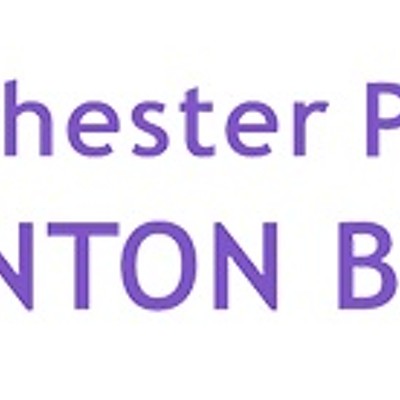The right to fight cancer
[
{
"name": "500x250 Ad",
"insertPoint": "5",
"component": "15667920",
"parentWrapperClass": "",
"requiredCountToDisplay": "1"
}
]
"Health is the last front in the civil rights movement," says Regina Bean.
When Bean found a small lump in her breast at age 20, she went to the doctor. She was assured it was a harmless cyst. In the summer of 2002, Bean was diagnosed with breast cancer and her "harmless" tumor was the size of a tangerine. Her left breast was lost to a mastectomy. One year later, she lost her right breast.
After her ordeal, she did advocacy work: on the committees for the Breast Cancer Coalition of Rochester and Women of Color (a Gilda's Club affiliate), sitting on the board for Women's Health at Highland Hospital, and with the Hadassah Teen Program. But, remembering her struggle as a young African American woman searching for adequate health care, she felt she had to do more.
"When you are dealing with cancer, you shouldn't have to worry about anything but getting better," Bean says.
Bean is still raising funds to get her nonprofit, The African American Breast Cancer Advocacy Group, going. Eventually she wants to be able to match up patients with advocates who will go to appointments, help with errands, and help track down support groups and other resources.
More African American women die from breast cancer than any other racial group, even though there are higher incidence rates in white women. The average age for breast cancer occurrence can be lower in black women, and many black women are diagnosed with a later stage.
"Many of our communities face continuous struggles with poverty, poor housing, lack of education, malnutrition and... health conditions that compromise the overall quality of life," says Bean. "Good health behavior, in many cases, is not a high priority."
For information: [email protected], Minorities Against Breast Cancer, P.O. Box 18446, Rochester, 14618.
--- Erin Morrison-Fortunato
The new math
It seems to defy all political wisdom.
A month ago, county officials solicited press coverage for an address by County Executive Maggie Brooks to the legislature's ways and means committee. In that address (and following press conferences) Brooks softened the news that Monroe County's 2005 finances were off to a worse-than-expected start by touting the "fact" that the county ended 2004 with a small surplus.
Then last week the Comprehensive Annual Financial Report came out, and with it the truth. In fact, the county's ending 2004 in the hole to the tune of $19.5 million. Administration Spokesman Larry Staub didn't return several phone calls seeking comment.
Curiously, the Dems, who have a habit of sending out press releases at the slightest provocation, are largely silent on this one.
"It's a misleading thing to say to the public that you have money in the bank when you know that you have bills due," says Minority Leader Stephanie Aldersley. But she stops short of calling Brooks' earlier press conference a lie.
"It's like they don't think the public has a memory," she says.
Or maybe Brooks' team just knows the public memory is short, and a month is a long time to bask in good press. If that's the case, this may not be the first use of a preemptive press conference, but it's probably the boldest.
In part to keep from getting hoodwinked like this again, the Democratic Party --- or more accurately one of its lej candidates, Travis Heider --- is dusting off an idea talked about last year but never publicized; Heider's calling for an elected county comptroller.
Of course, given the Republican hold on countywide offices, Dems might want to be careful what they wish for. But leaving that aside for a moment, let's pose this question: What did an elected comptroller do for Erie County? Not much, apparently.
The fact that they've had an elected comptroller hasn't helped stave off far larger deficits there ($118 million this year; $279 million by the end of the decade), and on Monday state Comptroller Alan Hevesi called for a state-run control board.
Tunnel vision
It seems the fiscal crisis in upstate New York's cities is becoming passé. With the last city budget proposal of the Bill Johnson era up for vote at the next City Council meeting, most people are talking about downtown's old subway tunnel and the city's plan to fill a portion of it with dirt.
A "Chill the Fill" movement has started, with the newly formed Subway Erie Canal Revitalization group appearing at summer festivals and hosting Sunday tours of the tunnel. The second tour, held this week, drew 323 people. "All but one of them," says organizer Pepsy Kettavong, "was against the fill."
The city plans to fill the underground tunnel with dirt from its "north portal" near Broad and Brown to the east side of Exchange Street. The project, slated for the end of the calendar year, will cost around $21 million, with $3 million provided by the state and $16 million from the feds.
The tunnel is really more of an underground bridge. It's gone largely unused for the past 50 years and has fallen into a state of disrepair. City Council is expected to vote on the fill this fall. The people opposed to it are planning to speak at the next City Council meeting. They're hoping the city will consider alternatives for the tunnel before plugging it. But, in many ways, that's already been done.
"We started looking at this in the early '90s," says City Engineer George Stam. "One of the options was to fill it in and reconstruct the roadway above it. We got the authorization from City Council, but they stipulated that we evaluate all available options, including reuse. That process has been ongoing."
Some of those options are the same ideas being suggested by SECR, including light rail. But Stam says the tunnel doesn't run along a "primary employment corridor." Other ideas to redirect the Erie Canal downtown are "technically feasible but hugely expensive," Stam says.
There was some concern that the fill-in would displace area homeless, who use the tunnel for shelter. But this section of the tunnel is not one that's typically used. The portion that is --- the Broad Street Bridge Aqueduct --- is in store for a different set of changes: a $4.7 million pedestrian walkway using $4.4 million in federal and state money.
Engineering and design work on the project is being done this year, with construction set to begin sometime in 2006. Space adjacent to the walkway, Stam says, would be available for a museum or commercial use.
City Council meets on Tuesday, June 14, in Council Chambers, City Hall, 30 Church Street, at 7 p.m.
The word on weed?
No.
In a 6-3 decision Monday, the Supreme Court said the feds can prosecute pot smokers, even if their activities are legit under medical marijuana laws in their home state. When City Newspaper spoke to New York lawmakers about pending medical marijuana legislation in this state (see "Joint decisions," May 25) they all insisted that whatever action the court took shouldn't --- and wouldn't --- influence the legislative process for that bill.
We'll see.
Changing of the film guard
Bill Coppard, executive director of the Little Theatre Film Society, is retiring on July 1. Film Society boardmember Dick Garth will take over the post. Coppard will stay on as artistic director, where he can still choose and fight for the types of films that have set the Little apart for 20-plus years.
"After 23 years it's about time to do something else," Coppard said at a press conference announcing his retirement. The challenge for Garth, he says, will be the same as always: "To expand the audience and become an even bigger part of Rochester."
Speaking of...
-

Little Theatre, big changes
Jun 22, 2005 -

Little Theatre, big changes
Jun 15, 2005 -
Reader feedback 8.27.03
Aug 27, 2003 - More »






